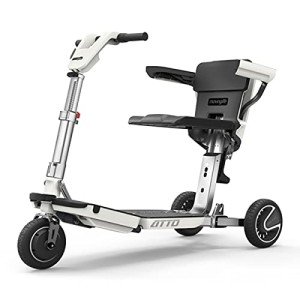Understanding Mobility Devices: Enhancing Independence and Quality of Life
In today's hectic world, the desire for mobility is universal. Nevertheless, collapsible scooters or age-related obstacles can hinder motion, leading to an ongoing search for assistance. Mobility devices function as important tools to boost independence, enhance quality of life, and allow individuals to engage totally in their neighborhoods. This post provides an extensive summary of mobility devices, including their types, functions, choice criteria, and more.
Kinds Of Mobility Devices
Mobility devices range from easy aids to complex devices, customized to meet different needs. Below is a table summarizing typical kinds of mobility devices:
| Type of Device | Description | Perfect For |
|---|---|---|
| Walkers | Four-legged support devices that provide exceptional stability while strolling. | Individuals needing extra support. |
| Walking sticks | Single or three-legged sticks that improve balance and support walking. | Those with minor mobility troubles. |
| Wheelchairs | Seats mounted on wheels, available in manual and electric versions. | People with minimal or no mobility. |
| Scooters | Electric lorries designed for outdoor usage and ease of navigation. | Those who can't stroll long ranges. |
| Crutches | Devices that assist individuals move weight away from a hurt leg. | People recovering from leg injuries. |
| Rollators | Walkers with wheels, seats, and brakes for boosted mobility. | Users needing rest alternatives while strolling. |
| Lift Chairs | Reclining chairs that help users in standing up and taking a seat. | Seniors or those with mobility restraints. |
| Mobility Scooters | Small electric lorries for minimal mobility, typically used outdoors. | People needing assistance over long ranges. |
Key Features of Mobility Devices
When choosing a mobility gadget, several key features need to be considered to ensure optimum performance and ease of usage:
- Weight Capacity: Understanding the gadget's weight constraint is crucial for safety and efficiency.
- Adjustability: Devices must be adjustable in height and width to fit the user comfortably.
- Mobility: Lightweight and foldable options are essential for users who travel or require transport.
- Stability and Safety: Look for features like anti-tip wheels and durable structures to enhance safety.
- Reduce of Use: Simple systems and easy to use designs can make a considerable distinction in day-to-day usage.
- Comfort: Ergonomic styles and cushioned seats can boost the user experience.
Picking the Right Mobility Device
Choosing the right mobility device can be a daunting job. Here are some actions to guide the decision-making process:
- Assess Needs: Evaluate the person's mobility obstacles and daily activities.
- Speak with a Professional: Engage healthcare professionals who can provide suggestions based on the individual's physical condition.
- Trial Options: If possible, trial various devices to identify convenience and performance.
- Evaluation Budget: Consider the cost of the gadget, consisting of any additional functions or modifications required.
- Research Options: Determine the very best brands and designs by reading reviews and comparisons.
Table: Comparative Analysis of Popular Mobility Devices
| Device | Benefits | Downsides |
|---|---|---|
| Walkers | Outstanding stability, promotes walking. | Bulky, may limit motion in small areas. |
| Canes | Lightweight, improves balance. | May not offer sufficient assistance for extreme mobility concerns. |
| Wheelchairs | Perfect for those with significant mobility limitations. | Can be troublesome, specifically in indoor environments. |
| Scooters | Great for outside use, simple to maneuver. | Minimal indoor functionality, much heavier. |
| Rollators | Supplies rest choice, easy to move. | May need more space than traditional walkers. |
| Lift Chairs | Comfortable, helps transition from sitting to standing. | More costly, bigger footprint. |
Often Asked Questions (FAQs)
1. What is a mobility device?
A mobility device is any tool developed to assist individuals in moving and browsing their environment. This includes walkers, wheelchairs, scooters, and crutches.
2. How do I know which mobility device is best for me?
Consider your specific mobility obstacles, physical capabilities, and lifestyle requirements. Consulting with healthcare experts can likewise offer customized recommendations.
3. Are mobility devices covered by insurance?
Numerous insurance strategies, including Medicare, might cover particular mobility devices. It's crucial to examine with your insurance coverage provider for specific coverage details.
4. Can I rent a mobility device rather of buying one?
Yes, many medical supply shops and drug stores offer leasings for mobility devices. This alternative is beneficial for people with short-lived mobility issues.
5. How can I keep my mobility device?
Regular upkeep is essential. It includes cleaning up the gadget, checking for wear and tear, and ensuring all parts are working properly.
The Impact of Mobility Devices on Quality of Life
Mobility devices considerably improve the lifestyle for people with restricted mobility. They cultivate independence, encourage social interaction, and improve access to essential services and leisure activities.
- Increased Independence: Users can navigate their communities, participate in occasions, and participate in pastimes without counting on others.
- Social Engagement: Mobility devices assist in involvement in social events, therefore combating sensations of isolation.
- Improved Safety: Devices offer stability and reduce the threat of falls, promoting user self-confidence.
Mobility devices are more than simply tools for movement; they are gateways to independence and quality living. By understanding the different types of mobility aids available, their key features, and considerations for choosing the best gadget, people can make informed decisions about their mobility needs. Eventually, the best mobility gadget can cause a more active, fulfilling life. Whether it's a walker, wheelchair, or scooter, the right choice contributes substantially to boosting the mobility and self-reliance of users.

